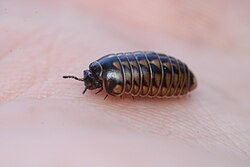Biology:Glomeris hexasticha
| Glomeris hexasticha | |
|---|---|

| |
| Scientific classification | |
| Domain: | Eukaryota |
| Kingdom: | Animalia |
| Phylum: | Arthropoda |
| Subphylum: | Myriapoda |
| Class: | Diplopoda |
| Order: | Glomerida |
| Family: | Glomeridae |
| Genus: | Glomeris |
| Species: | G. hexasticha
|
| Binomial name | |
| Glomeris hexasticha Brandt, 1833
| |
| Synonyms | |
|
List
| |
Glomeris hexasticha, also known as the eastern six-striped pill millipede or the diagonal-striped pill millipede, is a species of pill millipede within the family Glomeridae and order Glomerida.[1] The pill millipede is widely distributed within many European countries,[2] with the species consisting of over twenty different subspecies.[1]
Description
The body length of Glomeris hexasticha ranges from 6 to 17 mm long. Its exoskeleton displays a base colour ranging from brown to black, adorned with 7 rows (typically 6 in the eastern populations) of yellow-brown to red-brown spots. These lateral spots on the thoracic plate are large and always well-defined. The 2nd tergite of the species usually possesses a main furrow, accompanied by 0-1 pre-furrow and 2-4 subsidiary furrows. In males, the pre-anal tergite exhibits a prominent bulging of the rear margin, while in females, this bulge is less pronounced. Additionally, the male individuals exhibit a cross bulge above the rear margin.[3]
Distribution
Glomeris hexasticha possess a widespread European distribution where it can be found in the countries of: Albania, Austria, Bosnia and Herzegovina, Bulgaria, Croatia, Czech Republic, Germany , Hungary, Italy, North Macedonia, Poland , Romania, Serbia, Slovakia, Slovenia, Switzerland , Ukraine .[2][4] The species is also native to Central European Russia, European Turkey and the transcontinental region of the Near East.[4]
Habitat
Glomeris hexasticha mainly inhabitants forests located within montane and subalpine altitudes.[3] Forests can be both deciduous or coniferous, exhibiting tree species such as the common hornbeam (C. betulus) and black pine (Pinus nigra).[5] G. hexasticha has also been discovered to live on forest edges and within meadow habitat, where it is found living alongside wild wheat grasses (Agropyron sp.) and common rosehip (R. canina).[5] G. hexasticha is a detritivore feeding on decaying plant matter such as dead wood and leaves.[3]
Subspecies
Glomeris hexasticha contains 27 distinct subspecies:[1]
- Glomeris hexasticha bavarica Verhoeff, 1906
- Glomeris hexasticha boleti Verhoeff, 1906
- Glomeris hexasticha bosniensis Verhoeff, 1906
- Glomeris hexasticha calcivaga Verhoeff, 1906
- Glomeris hexasticha chiemensis Verhoeff, 1941
- Glomeris hexasticha eimeri Verhoeff, 1906
- Glomeris hexasticha hexasticha Verhoeff
- Glomeris hexasticha intermedia Latzel, 1884
- Glomeris hexasticha marcomannia Verhoeff, 1906
- Glomeris hexasticha quercivora Verhoeff, 1906
- Glomeris hexasticha rabensteinensis Verhoeff, 1906
- Glomeris hexasticha ruscorum Verhoeff, 1929
- Glomeris hexasticha suevica Verhoeff, 1911
- Glomeris hexasticha szeklerana Verhoeff, 1906
- Glomeris hexasticha theresiae Verhoeff, 1906
- Glomeris hexasticha trisulcata Rothenbühler, 1899
References
- ↑ 1.0 1.1 1.2 "Glomeris hexasticha Brandt, 1833". 2023-05-29. https://www.millibase.org/aphia.php?p=taxdetails&id=940596.
- ↑ 2.0 2.1 "Occurrences" (in en). https://www.gbif.org/occurrence/search?has_coordinate=true&has_geospatial_issue=false&taxon_key=1028094&geometry=POLYGON((-1.99107%2039.30761,43.99107%2039.30761,43.99107%2057.69239,-1.99107%2057.69239,-1.99107%2039.30761))&occurrence_status=present.
- ↑ 3.0 3.1 3.2 "Glomeris hexasticha Brandt, 1833 Schrägstreifiger Saftkugler". 2023-05-29. https://arthropodafotos.de/dbsp.php?lang=eng&sc=1&ta=t_86_glo_0_glom&sci=Glomeris&scisp=hexasticha.
- ↑ 4.0 4.1 "Glomeris hexasticha Brandt, 1833". 2023-05-31. https://fauna-eu.org/cdm_dataportal/taxon/2aaeca7e-41a5-4b66-a411-d5ec090db41d.
- ↑ 5.0 5.1 Bachvarova D. (2019) New record of Glomeris hexasticha Brandt, 1833 (Diplopoda: Glomerida: Glomeridae) from the Lilyaksko Plateau, North-Eastern Bulgaria. Acta Scientifica Naturalis, Vol.6 (Issue 2), pp. 55-61. doi:10.2478/asn-2019-0018
Wikidata ☰ Q4302249 entry
 |

